DNP-820 DPI Project Milestone: Healthy Work Environment in Nursing
VerifiedAdded on 2022/11/26
|12
|3156
|388
Project
AI Summary
This document presents a Direct Practice Improvement (DPI) project milestone focusing on assessing the healthy work environment of clinical research units, specifically within academic medical centers like Emory Healthcare and Grady Clinical Research Unit. The project aims to improve the working conditions of nurses, addressing issues like stress, fatigue, and protocol deviations. It includes a literature review covering the background of the problem, theoretical foundations (grounded theory, systems theory, and healthcare environment theory), and relevant literature topics. The project will employ a quantitative correlation study using the AACN Healthy Work Environment Assessment Tool (AACN HWEAT) to measure pre- and post-intervention scores, with a sample of 40 participants. The independent variable is an automated communication system, and the dependent variable is enhanced quality care and improved working environment. The project's significance lies in identifying interventions to strengthen the working conditions and the general environment, ultimately enhancing patient safety and nurse satisfaction. The study will be conducted over a 12-week period, including pre-assessment, intervention implementation, and post-assessment phases.
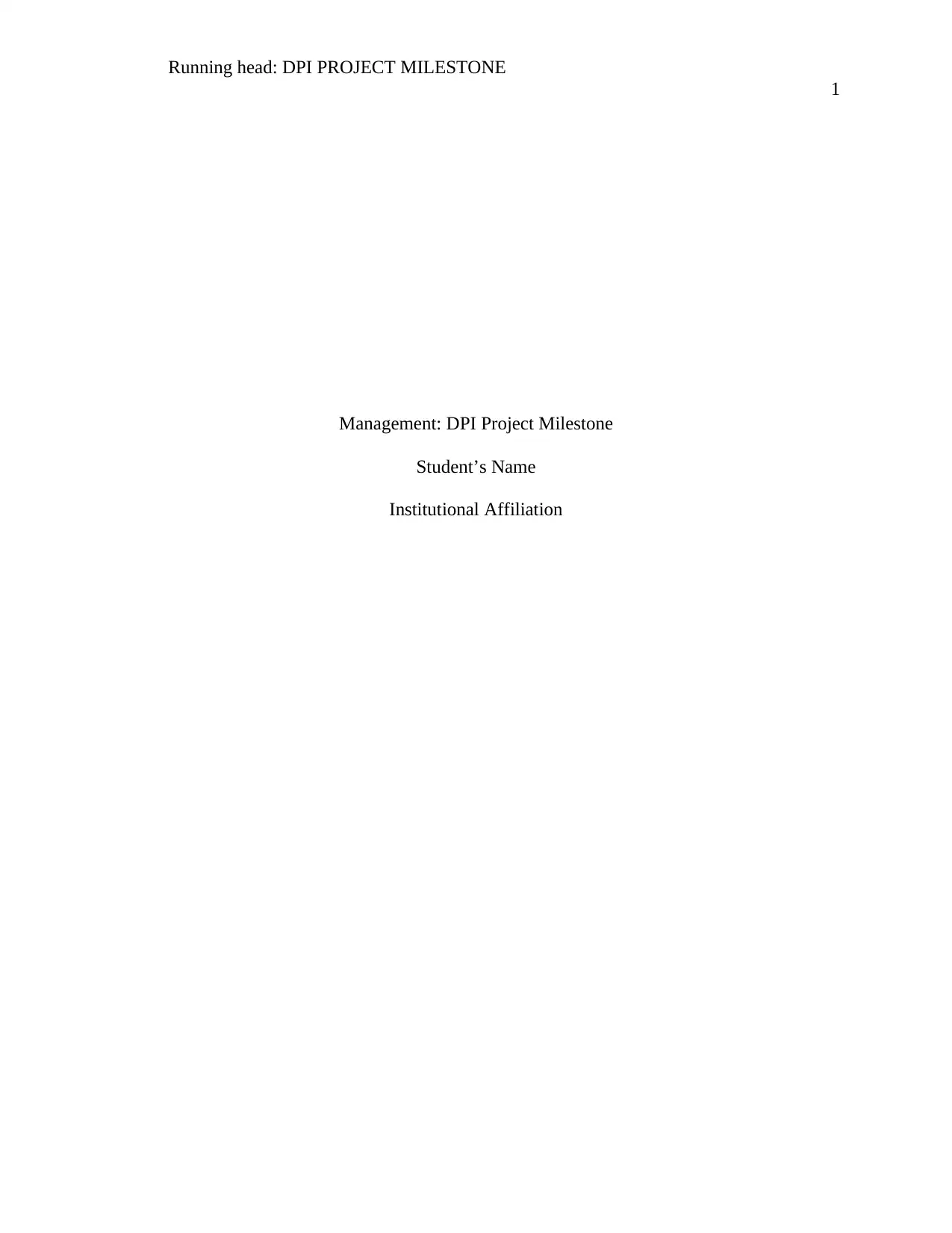
Running head: DPI PROJECT MILESTONE
1
Management: DPI Project Milestone
Student’s Name
Institutional Affiliation
1
Management: DPI Project Milestone
Student’s Name
Institutional Affiliation
Paraphrase This Document
Need a fresh take? Get an instant paraphrase of this document with our AI Paraphraser
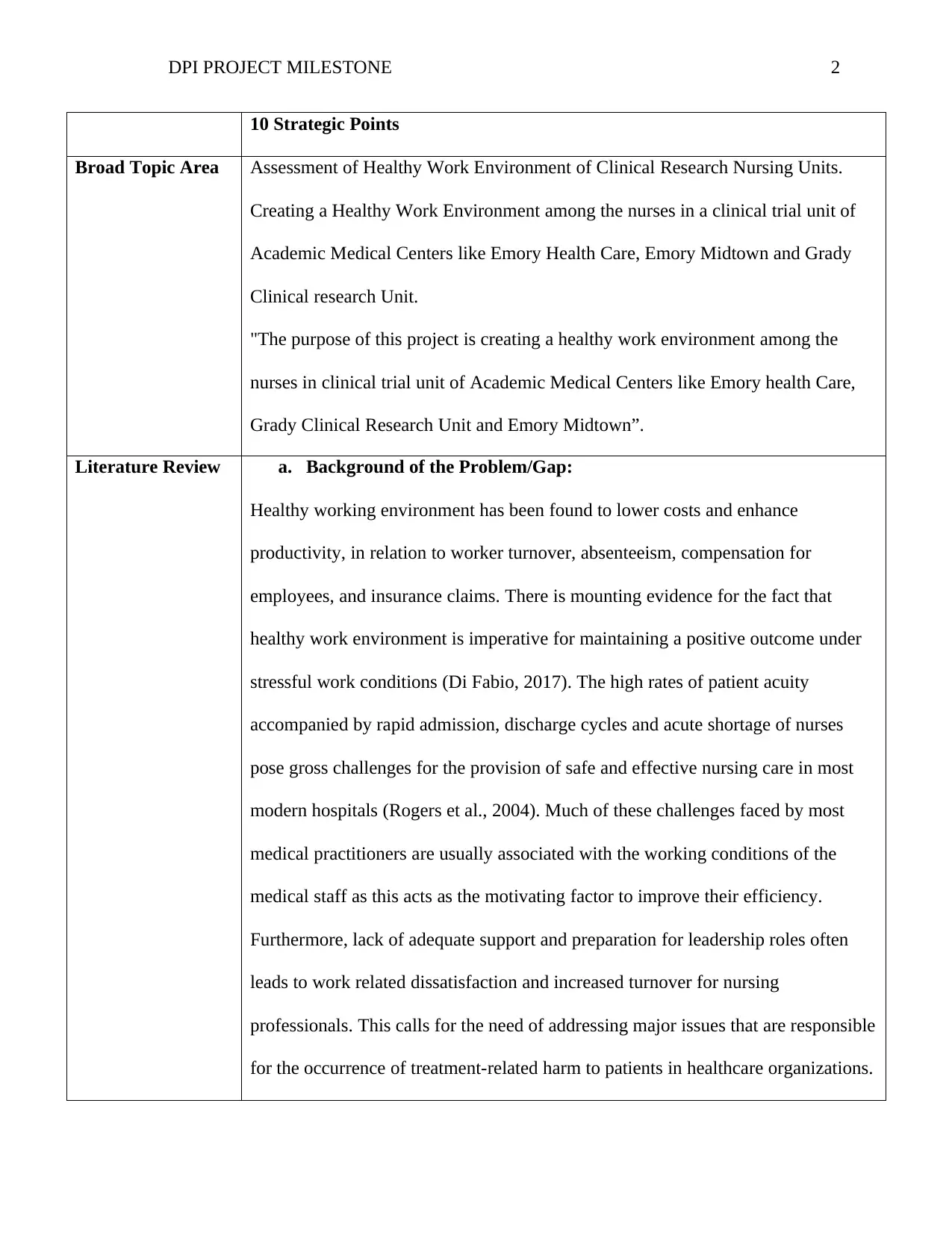
DPI PROJECT MILESTONE 2
10 Strategic Points
Broad Topic Area Assessment of Healthy Work Environment of Clinical Research Nursing Units.
Creating a Healthy Work Environment among the nurses in a clinical trial unit of
Academic Medical Centers like Emory Health Care, Emory Midtown and Grady
Clinical research Unit.
"The purpose of this project is creating a healthy work environment among the
nurses in clinical trial unit of Academic Medical Centers like Emory health Care,
Grady Clinical Research Unit and Emory Midtown”.
Literature Review a. Background of the Problem/Gap:
Healthy working environment has been found to lower costs and enhance
productivity, in relation to worker turnover, absenteeism, compensation for
employees, and insurance claims. There is mounting evidence for the fact that
healthy work environment is imperative for maintaining a positive outcome under
stressful work conditions (Di Fabio, 2017). The high rates of patient acuity
accompanied by rapid admission, discharge cycles and acute shortage of nurses
pose gross challenges for the provision of safe and effective nursing care in most
modern hospitals (Rogers et al., 2004). Much of these challenges faced by most
medical practitioners are usually associated with the working conditions of the
medical staff as this acts as the motivating factor to improve their efficiency.
Furthermore, lack of adequate support and preparation for leadership roles often
leads to work related dissatisfaction and increased turnover for nursing
professionals. This calls for the need of addressing major issues that are responsible
for the occurrence of treatment-related harm to patients in healthcare organizations.
10 Strategic Points
Broad Topic Area Assessment of Healthy Work Environment of Clinical Research Nursing Units.
Creating a Healthy Work Environment among the nurses in a clinical trial unit of
Academic Medical Centers like Emory Health Care, Emory Midtown and Grady
Clinical research Unit.
"The purpose of this project is creating a healthy work environment among the
nurses in clinical trial unit of Academic Medical Centers like Emory health Care,
Grady Clinical Research Unit and Emory Midtown”.
Literature Review a. Background of the Problem/Gap:
Healthy working environment has been found to lower costs and enhance
productivity, in relation to worker turnover, absenteeism, compensation for
employees, and insurance claims. There is mounting evidence for the fact that
healthy work environment is imperative for maintaining a positive outcome under
stressful work conditions (Di Fabio, 2017). The high rates of patient acuity
accompanied by rapid admission, discharge cycles and acute shortage of nurses
pose gross challenges for the provision of safe and effective nursing care in most
modern hospitals (Rogers et al., 2004). Much of these challenges faced by most
medical practitioners are usually associated with the working conditions of the
medical staff as this acts as the motivating factor to improve their efficiency.
Furthermore, lack of adequate support and preparation for leadership roles often
leads to work related dissatisfaction and increased turnover for nursing
professionals. This calls for the need of addressing major issues that are responsible
for the occurrence of treatment-related harm to patients in healthcare organizations.
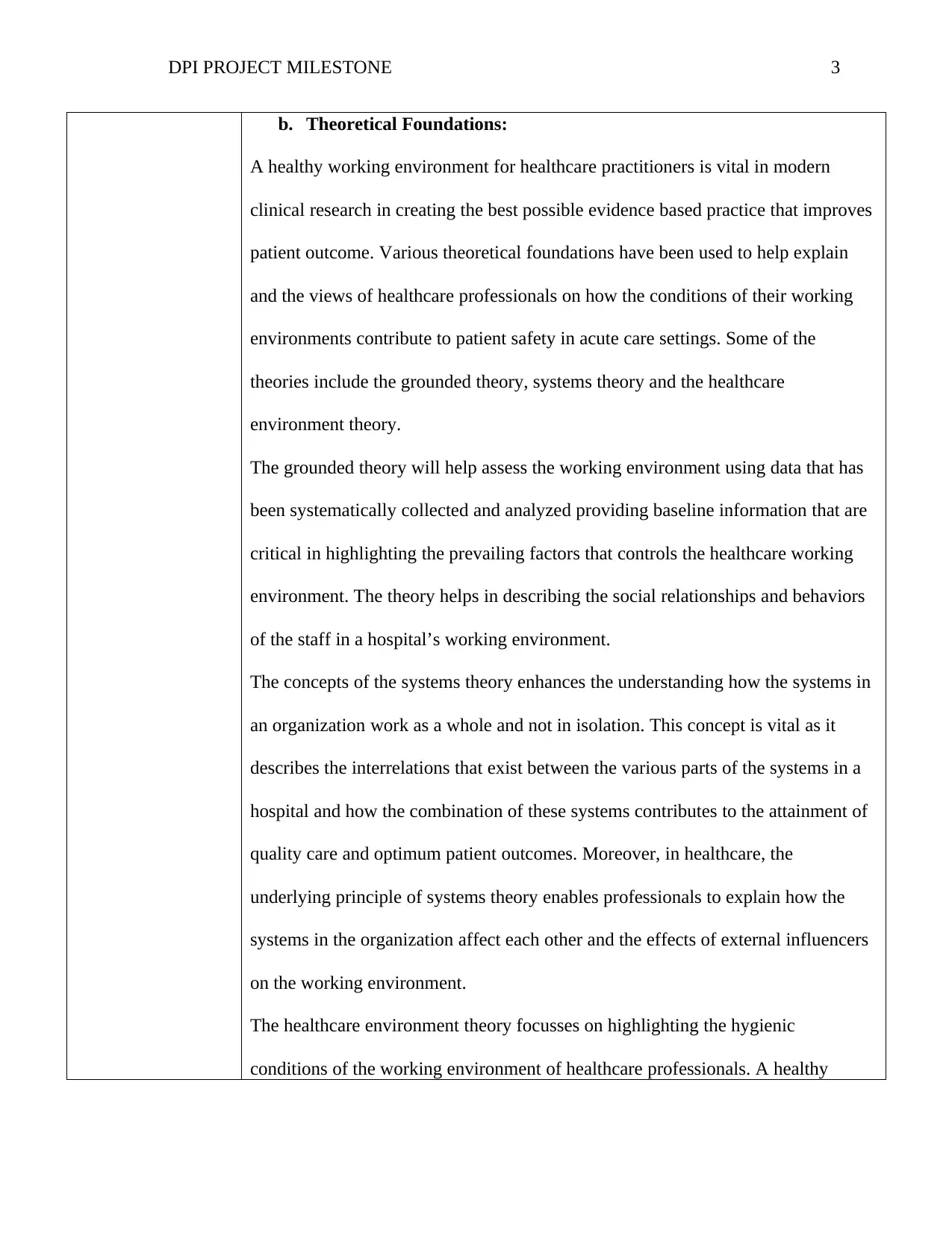
DPI PROJECT MILESTONE 3
b. Theoretical Foundations:
A healthy working environment for healthcare practitioners is vital in modern
clinical research in creating the best possible evidence based practice that improves
patient outcome. Various theoretical foundations have been used to help explain
and the views of healthcare professionals on how the conditions of their working
environments contribute to patient safety in acute care settings. Some of the
theories include the grounded theory, systems theory and the healthcare
environment theory.
The grounded theory will help assess the working environment using data that has
been systematically collected and analyzed providing baseline information that are
critical in highlighting the prevailing factors that controls the healthcare working
environment. The theory helps in describing the social relationships and behaviors
of the staff in a hospital’s working environment.
The concepts of the systems theory enhances the understanding how the systems in
an organization work as a whole and not in isolation. This concept is vital as it
describes the interrelations that exist between the various parts of the systems in a
hospital and how the combination of these systems contributes to the attainment of
quality care and optimum patient outcomes. Moreover, in healthcare, the
underlying principle of systems theory enables professionals to explain how the
systems in the organization affect each other and the effects of external influencers
on the working environment.
The healthcare environment theory focusses on highlighting the hygienic
conditions of the working environment of healthcare professionals. A healthy
b. Theoretical Foundations:
A healthy working environment for healthcare practitioners is vital in modern
clinical research in creating the best possible evidence based practice that improves
patient outcome. Various theoretical foundations have been used to help explain
and the views of healthcare professionals on how the conditions of their working
environments contribute to patient safety in acute care settings. Some of the
theories include the grounded theory, systems theory and the healthcare
environment theory.
The grounded theory will help assess the working environment using data that has
been systematically collected and analyzed providing baseline information that are
critical in highlighting the prevailing factors that controls the healthcare working
environment. The theory helps in describing the social relationships and behaviors
of the staff in a hospital’s working environment.
The concepts of the systems theory enhances the understanding how the systems in
an organization work as a whole and not in isolation. This concept is vital as it
describes the interrelations that exist between the various parts of the systems in a
hospital and how the combination of these systems contributes to the attainment of
quality care and optimum patient outcomes. Moreover, in healthcare, the
underlying principle of systems theory enables professionals to explain how the
systems in the organization affect each other and the effects of external influencers
on the working environment.
The healthcare environment theory focusses on highlighting the hygienic
conditions of the working environment of healthcare professionals. A healthy
⊘ This is a preview!⊘
Do you want full access?
Subscribe today to unlock all pages.

Trusted by 1+ million students worldwide
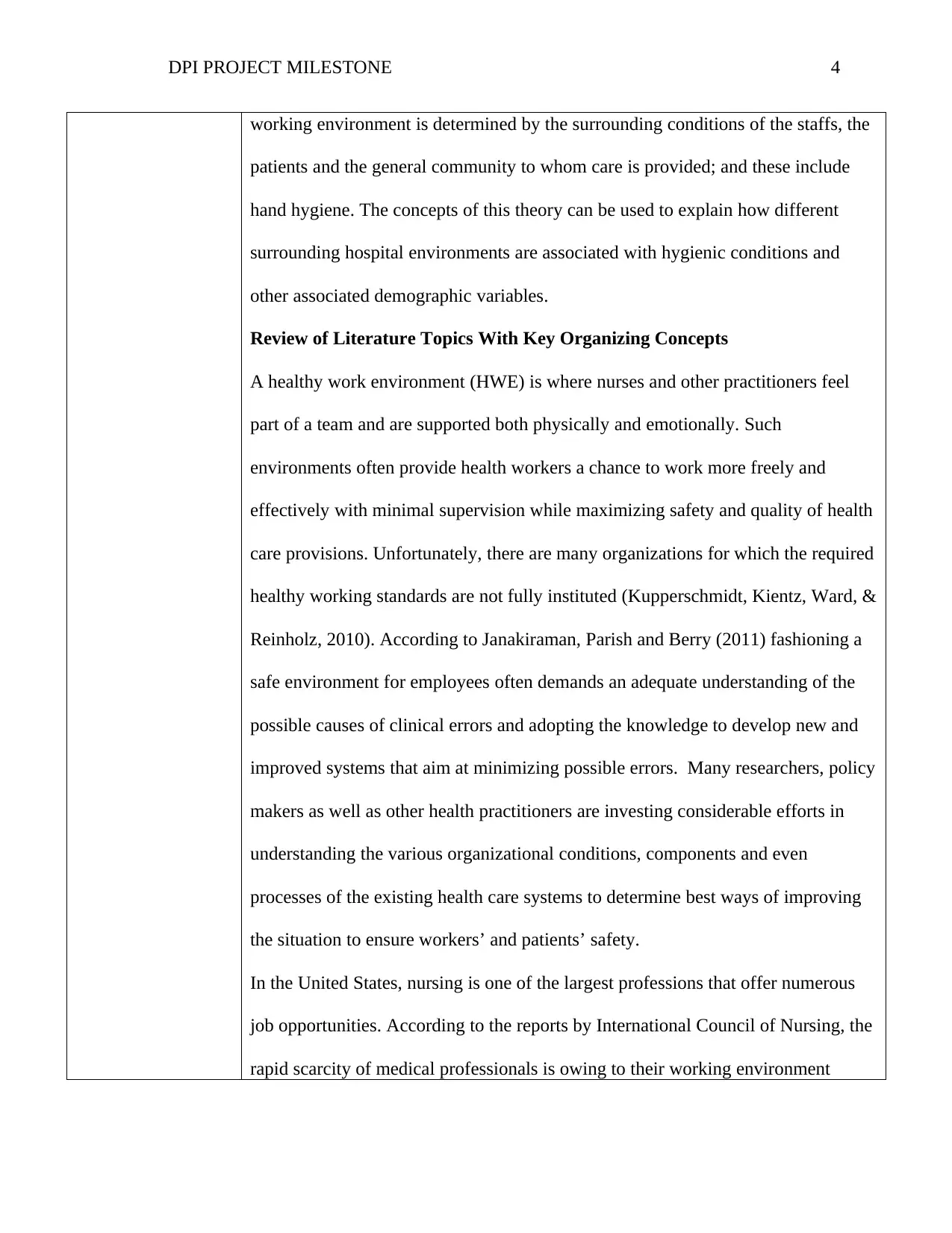
DPI PROJECT MILESTONE 4
working environment is determined by the surrounding conditions of the staffs, the
patients and the general community to whom care is provided; and these include
hand hygiene. The concepts of this theory can be used to explain how different
surrounding hospital environments are associated with hygienic conditions and
other associated demographic variables.
Review of Literature Topics With Key Organizing Concepts
A healthy work environment (HWE) is where nurses and other practitioners feel
part of a team and are supported both physically and emotionally. Such
environments often provide health workers a chance to work more freely and
effectively with minimal supervision while maximizing safety and quality of health
care provisions. Unfortunately, there are many organizations for which the required
healthy working standards are not fully instituted (Kupperschmidt, Kientz, Ward, &
Reinholz, 2010). According to Janakiraman, Parish and Berry (2011) fashioning a
safe environment for employees often demands an adequate understanding of the
possible causes of clinical errors and adopting the knowledge to develop new and
improved systems that aim at minimizing possible errors. Many researchers, policy
makers as well as other health practitioners are investing considerable efforts in
understanding the various organizational conditions, components and even
processes of the existing health care systems to determine best ways of improving
the situation to ensure workers’ and patients’ safety.
In the United States, nursing is one of the largest professions that offer numerous
job opportunities. According to the reports by International Council of Nursing, the
rapid scarcity of medical professionals is owing to their working environment
working environment is determined by the surrounding conditions of the staffs, the
patients and the general community to whom care is provided; and these include
hand hygiene. The concepts of this theory can be used to explain how different
surrounding hospital environments are associated with hygienic conditions and
other associated demographic variables.
Review of Literature Topics With Key Organizing Concepts
A healthy work environment (HWE) is where nurses and other practitioners feel
part of a team and are supported both physically and emotionally. Such
environments often provide health workers a chance to work more freely and
effectively with minimal supervision while maximizing safety and quality of health
care provisions. Unfortunately, there are many organizations for which the required
healthy working standards are not fully instituted (Kupperschmidt, Kientz, Ward, &
Reinholz, 2010). According to Janakiraman, Parish and Berry (2011) fashioning a
safe environment for employees often demands an adequate understanding of the
possible causes of clinical errors and adopting the knowledge to develop new and
improved systems that aim at minimizing possible errors. Many researchers, policy
makers as well as other health practitioners are investing considerable efforts in
understanding the various organizational conditions, components and even
processes of the existing health care systems to determine best ways of improving
the situation to ensure workers’ and patients’ safety.
In the United States, nursing is one of the largest professions that offer numerous
job opportunities. According to the reports by International Council of Nursing, the
rapid scarcity of medical professionals is owing to their working environment
Paraphrase This Document
Need a fresh take? Get an instant paraphrase of this document with our AI Paraphraser
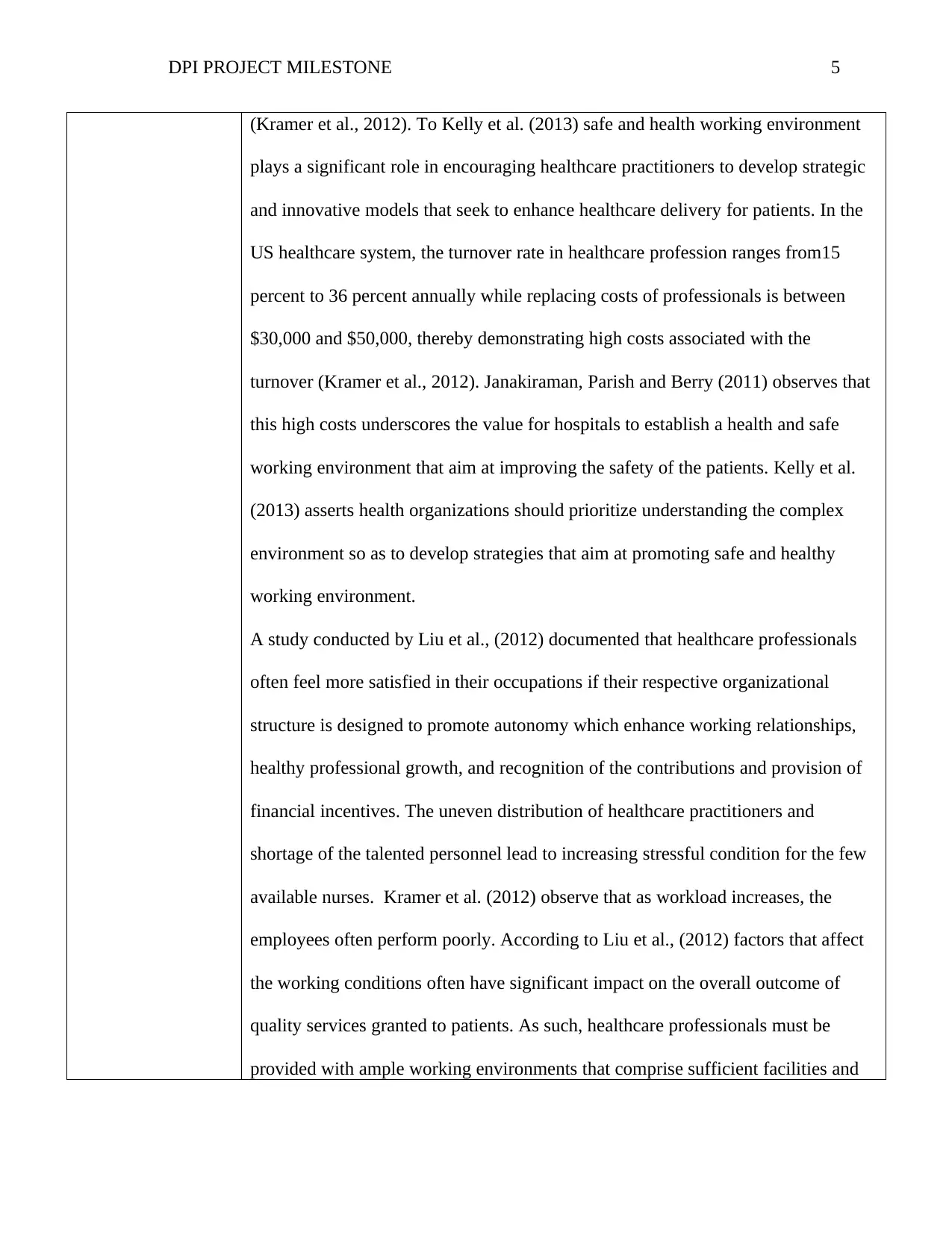
DPI PROJECT MILESTONE 5
(Kramer et al., 2012). To Kelly et al. (2013) safe and health working environment
plays a significant role in encouraging healthcare practitioners to develop strategic
and innovative models that seek to enhance healthcare delivery for patients. In the
US healthcare system, the turnover rate in healthcare profession ranges from15
percent to 36 percent annually while replacing costs of professionals is between
$30,000 and $50,000, thereby demonstrating high costs associated with the
turnover (Kramer et al., 2012). Janakiraman, Parish and Berry (2011) observes that
this high costs underscores the value for hospitals to establish a health and safe
working environment that aim at improving the safety of the patients. Kelly et al.
(2013) asserts health organizations should prioritize understanding the complex
environment so as to develop strategies that aim at promoting safe and healthy
working environment.
A study conducted by Liu et al., (2012) documented that healthcare professionals
often feel more satisfied in their occupations if their respective organizational
structure is designed to promote autonomy which enhance working relationships,
healthy professional growth, and recognition of the contributions and provision of
financial incentives. The uneven distribution of healthcare practitioners and
shortage of the talented personnel lead to increasing stressful condition for the few
available nurses. Kramer et al. (2012) observe that as workload increases, the
employees often perform poorly. According to Liu et al., (2012) factors that affect
the working conditions often have significant impact on the overall outcome of
quality services granted to patients. As such, healthcare professionals must be
provided with ample working environments that comprise sufficient facilities and
(Kramer et al., 2012). To Kelly et al. (2013) safe and health working environment
plays a significant role in encouraging healthcare practitioners to develop strategic
and innovative models that seek to enhance healthcare delivery for patients. In the
US healthcare system, the turnover rate in healthcare profession ranges from15
percent to 36 percent annually while replacing costs of professionals is between
$30,000 and $50,000, thereby demonstrating high costs associated with the
turnover (Kramer et al., 2012). Janakiraman, Parish and Berry (2011) observes that
this high costs underscores the value for hospitals to establish a health and safe
working environment that aim at improving the safety of the patients. Kelly et al.
(2013) asserts health organizations should prioritize understanding the complex
environment so as to develop strategies that aim at promoting safe and healthy
working environment.
A study conducted by Liu et al., (2012) documented that healthcare professionals
often feel more satisfied in their occupations if their respective organizational
structure is designed to promote autonomy which enhance working relationships,
healthy professional growth, and recognition of the contributions and provision of
financial incentives. The uneven distribution of healthcare practitioners and
shortage of the talented personnel lead to increasing stressful condition for the few
available nurses. Kramer et al. (2012) observe that as workload increases, the
employees often perform poorly. According to Liu et al., (2012) factors that affect
the working conditions often have significant impact on the overall outcome of
quality services granted to patients. As such, healthcare professionals must be
provided with ample working environments that comprise sufficient facilities and
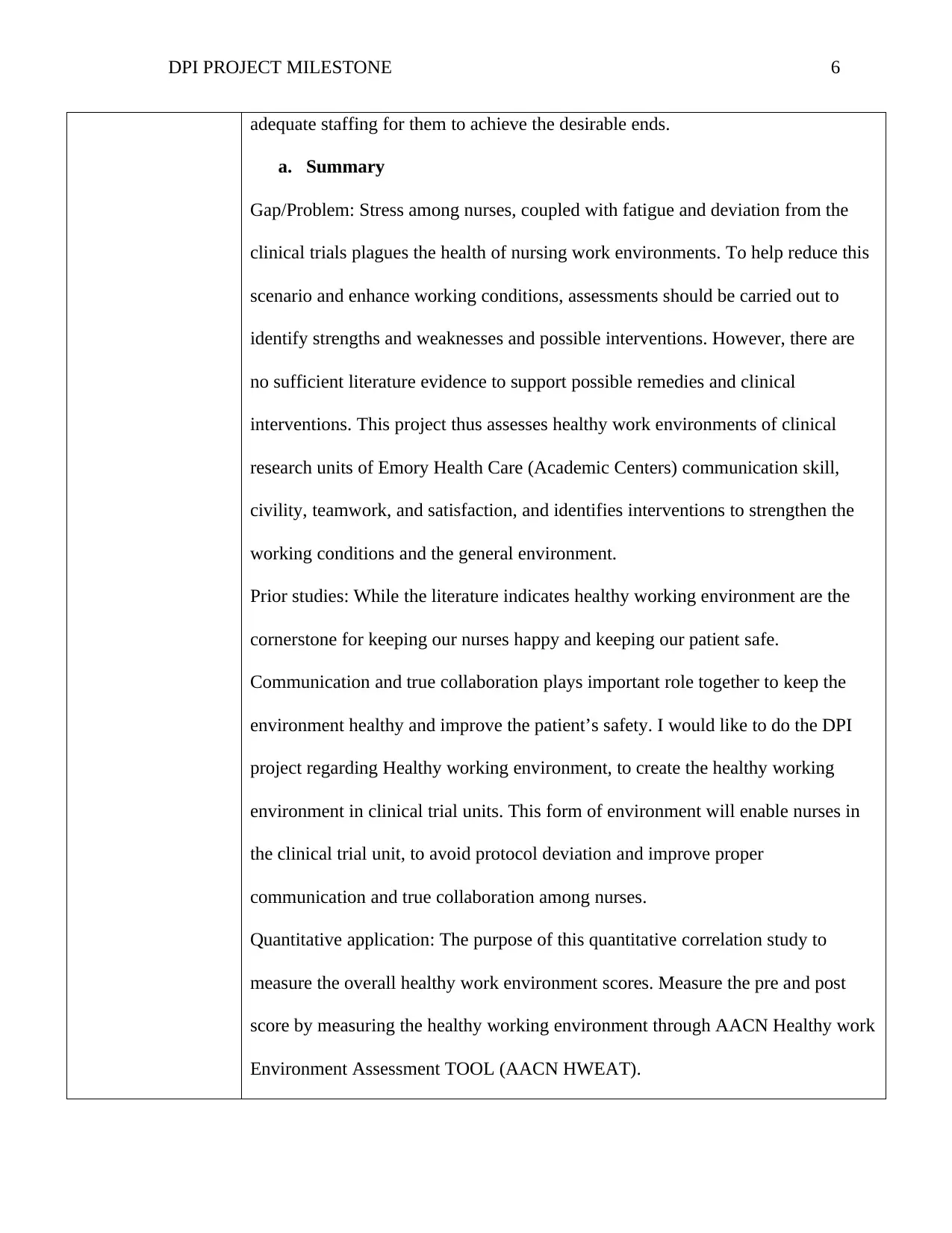
DPI PROJECT MILESTONE 6
adequate staffing for them to achieve the desirable ends.
a. Summary
Gap/Problem: Stress among nurses, coupled with fatigue and deviation from the
clinical trials plagues the health of nursing work environments. To help reduce this
scenario and enhance working conditions, assessments should be carried out to
identify strengths and weaknesses and possible interventions. However, there are
no sufficient literature evidence to support possible remedies and clinical
interventions. This project thus assesses healthy work environments of clinical
research units of Emory Health Care (Academic Centers) communication skill,
civility, teamwork, and satisfaction, and identifies interventions to strengthen the
working conditions and the general environment.
Prior studies: While the literature indicates healthy working environment are the
cornerstone for keeping our nurses happy and keeping our patient safe.
Communication and true collaboration plays important role together to keep the
environment healthy and improve the patient’s safety. I would like to do the DPI
project regarding Healthy working environment, to create the healthy working
environment in clinical trial units. This form of environment will enable nurses in
the clinical trial unit, to avoid protocol deviation and improve proper
communication and true collaboration among nurses.
Quantitative application: The purpose of this quantitative correlation study to
measure the overall healthy work environment scores. Measure the pre and post
score by measuring the healthy working environment through AACN Healthy work
Environment Assessment TOOL (AACN HWEAT).
adequate staffing for them to achieve the desirable ends.
a. Summary
Gap/Problem: Stress among nurses, coupled with fatigue and deviation from the
clinical trials plagues the health of nursing work environments. To help reduce this
scenario and enhance working conditions, assessments should be carried out to
identify strengths and weaknesses and possible interventions. However, there are
no sufficient literature evidence to support possible remedies and clinical
interventions. This project thus assesses healthy work environments of clinical
research units of Emory Health Care (Academic Centers) communication skill,
civility, teamwork, and satisfaction, and identifies interventions to strengthen the
working conditions and the general environment.
Prior studies: While the literature indicates healthy working environment are the
cornerstone for keeping our nurses happy and keeping our patient safe.
Communication and true collaboration plays important role together to keep the
environment healthy and improve the patient’s safety. I would like to do the DPI
project regarding Healthy working environment, to create the healthy working
environment in clinical trial units. This form of environment will enable nurses in
the clinical trial unit, to avoid protocol deviation and improve proper
communication and true collaboration among nurses.
Quantitative application: The purpose of this quantitative correlation study to
measure the overall healthy work environment scores. Measure the pre and post
score by measuring the healthy working environment through AACN Healthy work
Environment Assessment TOOL (AACN HWEAT).
⊘ This is a preview!⊘
Do you want full access?
Subscribe today to unlock all pages.

Trusted by 1+ million students worldwide
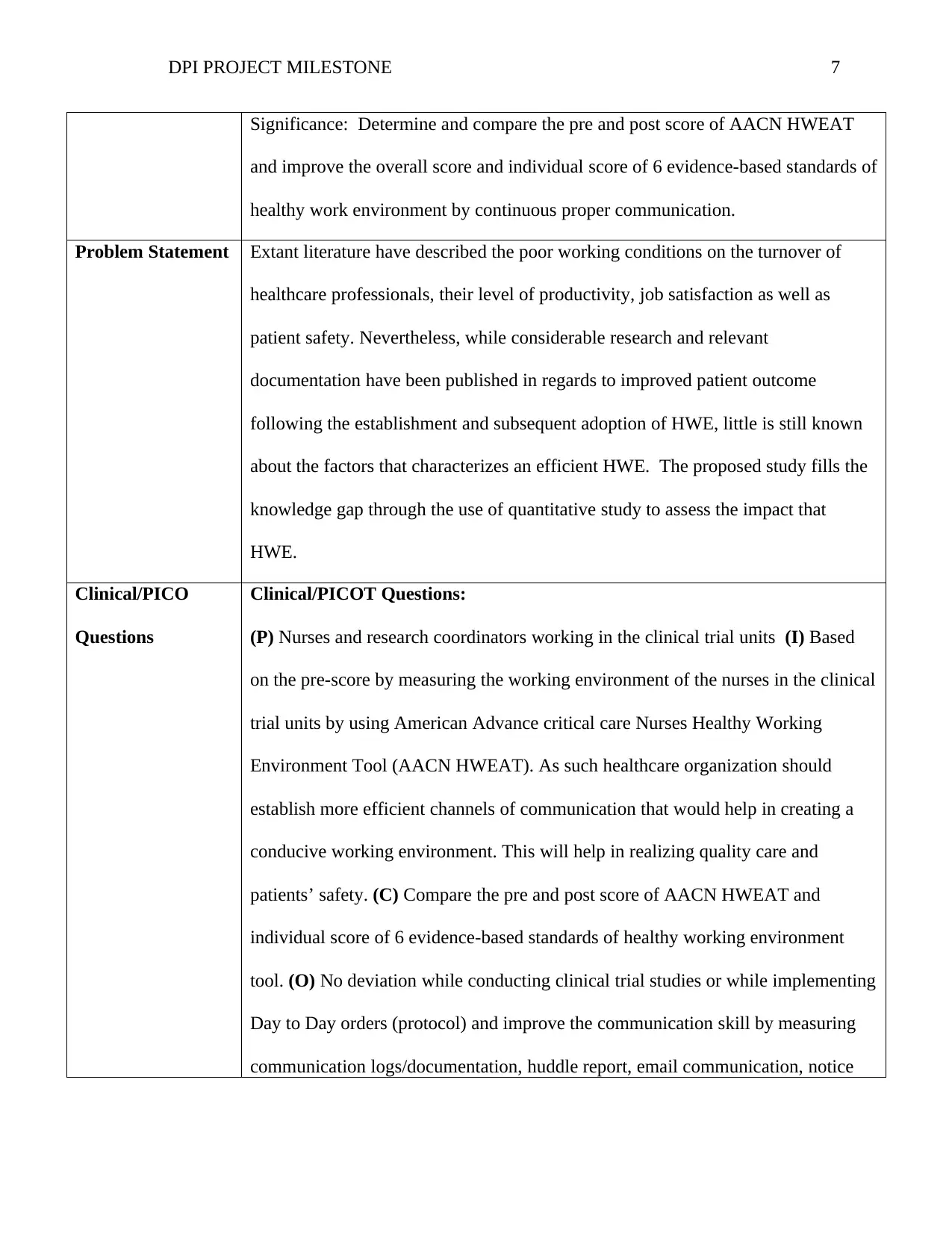
DPI PROJECT MILESTONE 7
Significance: Determine and compare the pre and post score of AACN HWEAT
and improve the overall score and individual score of 6 evidence-based standards of
healthy work environment by continuous proper communication.
Problem Statement Extant literature have described the poor working conditions on the turnover of
healthcare professionals, their level of productivity, job satisfaction as well as
patient safety. Nevertheless, while considerable research and relevant
documentation have been published in regards to improved patient outcome
following the establishment and subsequent adoption of HWE, little is still known
about the factors that characterizes an efficient HWE. The proposed study fills the
knowledge gap through the use of quantitative study to assess the impact that
HWE.
Clinical/PICO
Questions
Clinical/PICOT Questions:
(P) Nurses and research coordinators working in the clinical trial units (I) Based
on the pre-score by measuring the working environment of the nurses in the clinical
trial units by using American Advance critical care Nurses Healthy Working
Environment Tool (AACN HWEAT). As such healthcare organization should
establish more efficient channels of communication that would help in creating a
conducive working environment. This will help in realizing quality care and
patients’ safety. (C) Compare the pre and post score of AACN HWEAT and
individual score of 6 evidence-based standards of healthy working environment
tool. (O) No deviation while conducting clinical trial studies or while implementing
Day to Day orders (protocol) and improve the communication skill by measuring
communication logs/documentation, huddle report, email communication, notice
Significance: Determine and compare the pre and post score of AACN HWEAT
and improve the overall score and individual score of 6 evidence-based standards of
healthy work environment by continuous proper communication.
Problem Statement Extant literature have described the poor working conditions on the turnover of
healthcare professionals, their level of productivity, job satisfaction as well as
patient safety. Nevertheless, while considerable research and relevant
documentation have been published in regards to improved patient outcome
following the establishment and subsequent adoption of HWE, little is still known
about the factors that characterizes an efficient HWE. The proposed study fills the
knowledge gap through the use of quantitative study to assess the impact that
HWE.
Clinical/PICO
Questions
Clinical/PICOT Questions:
(P) Nurses and research coordinators working in the clinical trial units (I) Based
on the pre-score by measuring the working environment of the nurses in the clinical
trial units by using American Advance critical care Nurses Healthy Working
Environment Tool (AACN HWEAT). As such healthcare organization should
establish more efficient channels of communication that would help in creating a
conducive working environment. This will help in realizing quality care and
patients’ safety. (C) Compare the pre and post score of AACN HWEAT and
individual score of 6 evidence-based standards of healthy working environment
tool. (O) No deviation while conducting clinical trial studies or while implementing
Day to Day orders (protocol) and improve the communication skill by measuring
communication logs/documentation, huddle report, email communication, notice
Paraphrase This Document
Need a fresh take? Get an instant paraphrase of this document with our AI Paraphraser
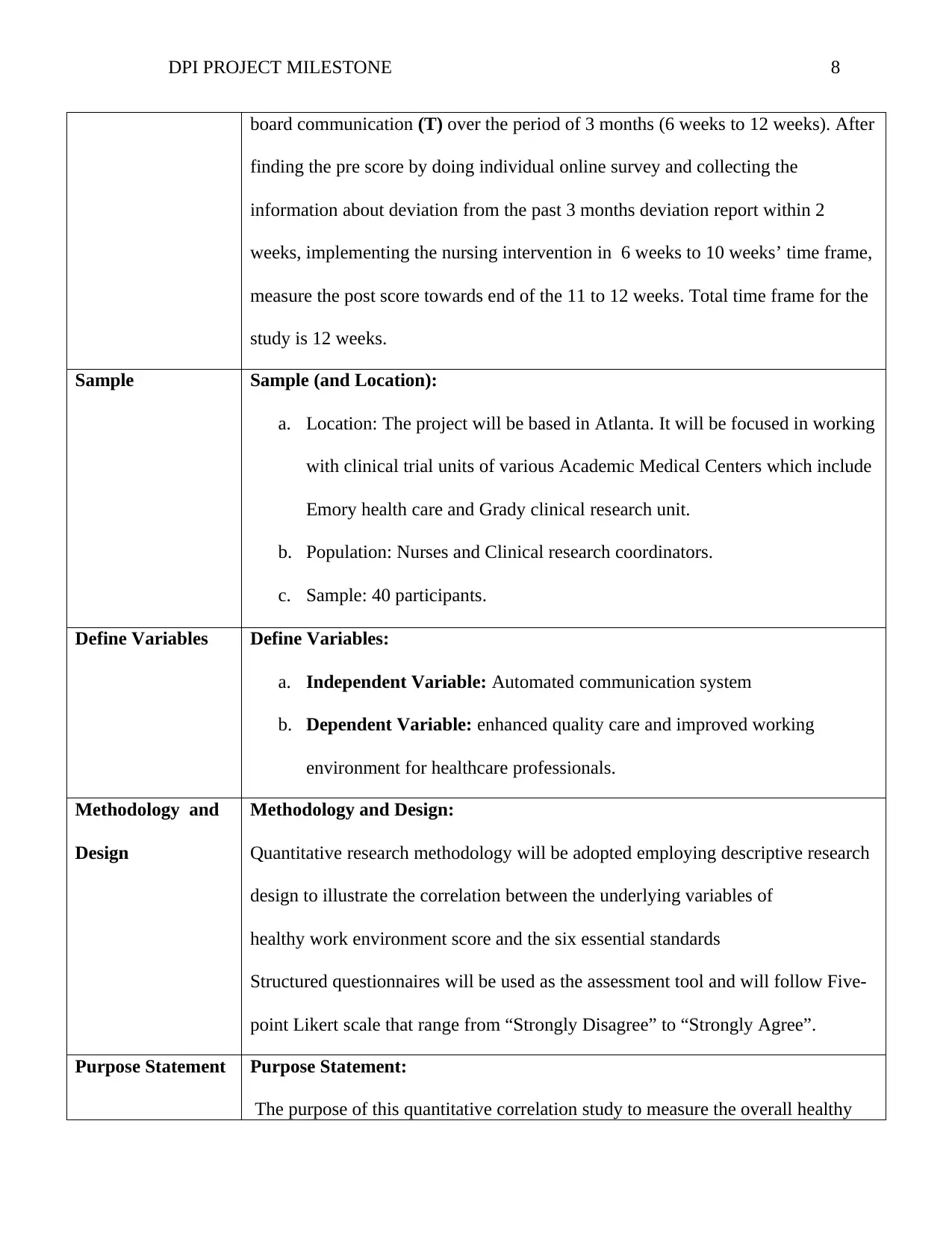
DPI PROJECT MILESTONE 8
board communication (T) over the period of 3 months (6 weeks to 12 weeks). After
finding the pre score by doing individual online survey and collecting the
information about deviation from the past 3 months deviation report within 2
weeks, implementing the nursing intervention in 6 weeks to 10 weeks’ time frame,
measure the post score towards end of the 11 to 12 weeks. Total time frame for the
study is 12 weeks.
Sample Sample (and Location):
a. Location: The project will be based in Atlanta. It will be focused in working
with clinical trial units of various Academic Medical Centers which include
Emory health care and Grady clinical research unit.
b. Population: Nurses and Clinical research coordinators.
c. Sample: 40 participants.
Define Variables Define Variables:
a. Independent Variable: Automated communication system
b. Dependent Variable: enhanced quality care and improved working
environment for healthcare professionals.
Methodology and
Design
Methodology and Design:
Quantitative research methodology will be adopted employing descriptive research
design to illustrate the correlation between the underlying variables of
healthy work environment score and the six essential standards
Structured questionnaires will be used as the assessment tool and will follow Five-
point Likert scale that range from “Strongly Disagree” to “Strongly Agree”.
Purpose Statement Purpose Statement:
The purpose of this quantitative correlation study to measure the overall healthy
board communication (T) over the period of 3 months (6 weeks to 12 weeks). After
finding the pre score by doing individual online survey and collecting the
information about deviation from the past 3 months deviation report within 2
weeks, implementing the nursing intervention in 6 weeks to 10 weeks’ time frame,
measure the post score towards end of the 11 to 12 weeks. Total time frame for the
study is 12 weeks.
Sample Sample (and Location):
a. Location: The project will be based in Atlanta. It will be focused in working
with clinical trial units of various Academic Medical Centers which include
Emory health care and Grady clinical research unit.
b. Population: Nurses and Clinical research coordinators.
c. Sample: 40 participants.
Define Variables Define Variables:
a. Independent Variable: Automated communication system
b. Dependent Variable: enhanced quality care and improved working
environment for healthcare professionals.
Methodology and
Design
Methodology and Design:
Quantitative research methodology will be adopted employing descriptive research
design to illustrate the correlation between the underlying variables of
healthy work environment score and the six essential standards
Structured questionnaires will be used as the assessment tool and will follow Five-
point Likert scale that range from “Strongly Disagree” to “Strongly Agree”.
Purpose Statement Purpose Statement:
The purpose of this quantitative correlation study to measure the overall healthy
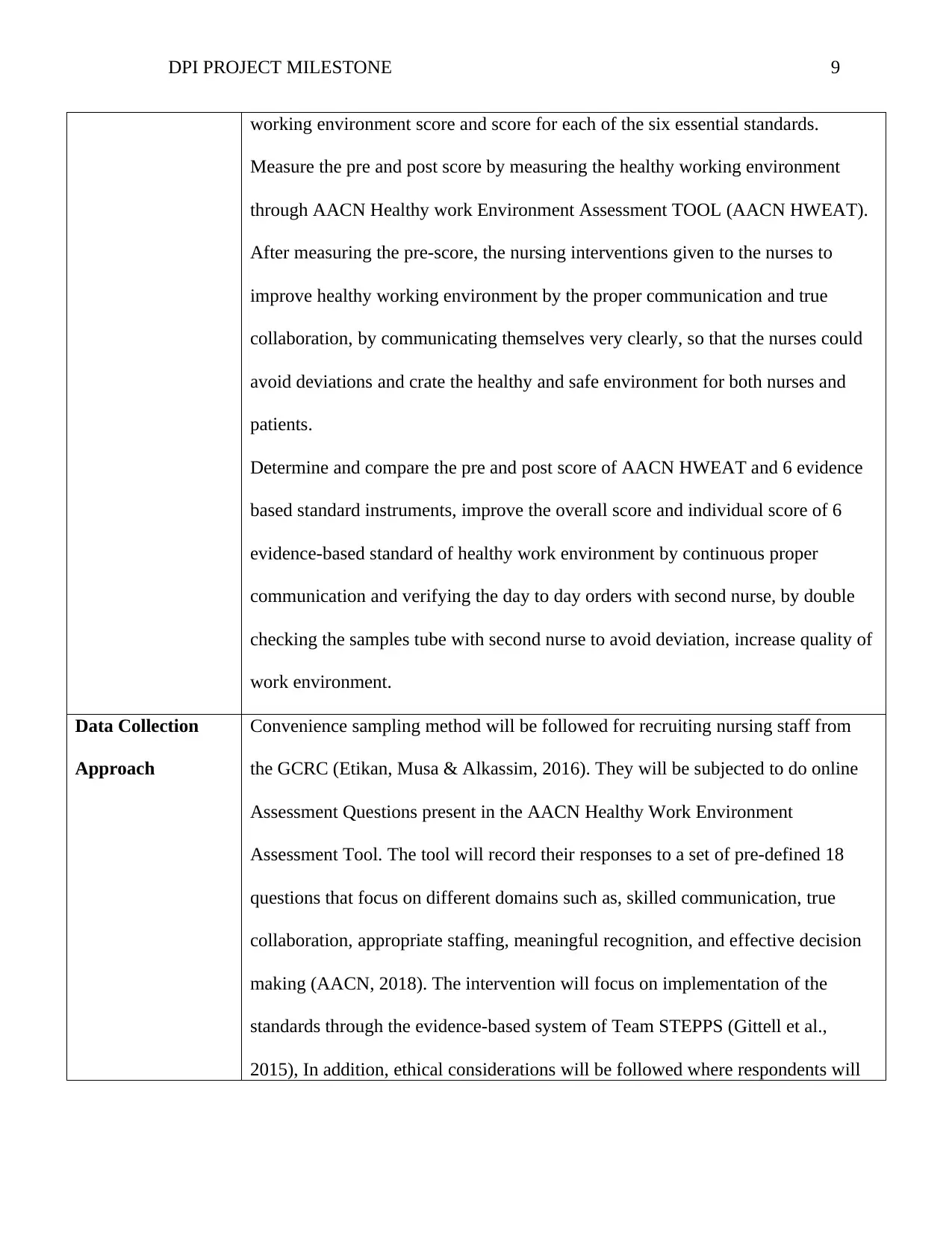
DPI PROJECT MILESTONE 9
working environment score and score for each of the six essential standards.
Measure the pre and post score by measuring the healthy working environment
through AACN Healthy work Environment Assessment TOOL (AACN HWEAT).
After measuring the pre-score, the nursing interventions given to the nurses to
improve healthy working environment by the proper communication and true
collaboration, by communicating themselves very clearly, so that the nurses could
avoid deviations and crate the healthy and safe environment for both nurses and
patients.
Determine and compare the pre and post score of AACN HWEAT and 6 evidence
based standard instruments, improve the overall score and individual score of 6
evidence-based standard of healthy work environment by continuous proper
communication and verifying the day to day orders with second nurse, by double
checking the samples tube with second nurse to avoid deviation, increase quality of
work environment.
Data Collection
Approach
Convenience sampling method will be followed for recruiting nursing staff from
the GCRC (Etikan, Musa & Alkassim, 2016). They will be subjected to do online
Assessment Questions present in the AACN Healthy Work Environment
Assessment Tool. The tool will record their responses to a set of pre-defined 18
questions that focus on different domains such as, skilled communication, true
collaboration, appropriate staffing, meaningful recognition, and effective decision
making (AACN, 2018). The intervention will focus on implementation of the
standards through the evidence-based system of Team STEPPS (Gittell et al.,
2015), In addition, ethical considerations will be followed where respondents will
working environment score and score for each of the six essential standards.
Measure the pre and post score by measuring the healthy working environment
through AACN Healthy work Environment Assessment TOOL (AACN HWEAT).
After measuring the pre-score, the nursing interventions given to the nurses to
improve healthy working environment by the proper communication and true
collaboration, by communicating themselves very clearly, so that the nurses could
avoid deviations and crate the healthy and safe environment for both nurses and
patients.
Determine and compare the pre and post score of AACN HWEAT and 6 evidence
based standard instruments, improve the overall score and individual score of 6
evidence-based standard of healthy work environment by continuous proper
communication and verifying the day to day orders with second nurse, by double
checking the samples tube with second nurse to avoid deviation, increase quality of
work environment.
Data Collection
Approach
Convenience sampling method will be followed for recruiting nursing staff from
the GCRC (Etikan, Musa & Alkassim, 2016). They will be subjected to do online
Assessment Questions present in the AACN Healthy Work Environment
Assessment Tool. The tool will record their responses to a set of pre-defined 18
questions that focus on different domains such as, skilled communication, true
collaboration, appropriate staffing, meaningful recognition, and effective decision
making (AACN, 2018). The intervention will focus on implementation of the
standards through the evidence-based system of Team STEPPS (Gittell et al.,
2015), In addition, ethical considerations will be followed where respondents will
⊘ This is a preview!⊘
Do you want full access?
Subscribe today to unlock all pages.

Trusted by 1+ million students worldwide
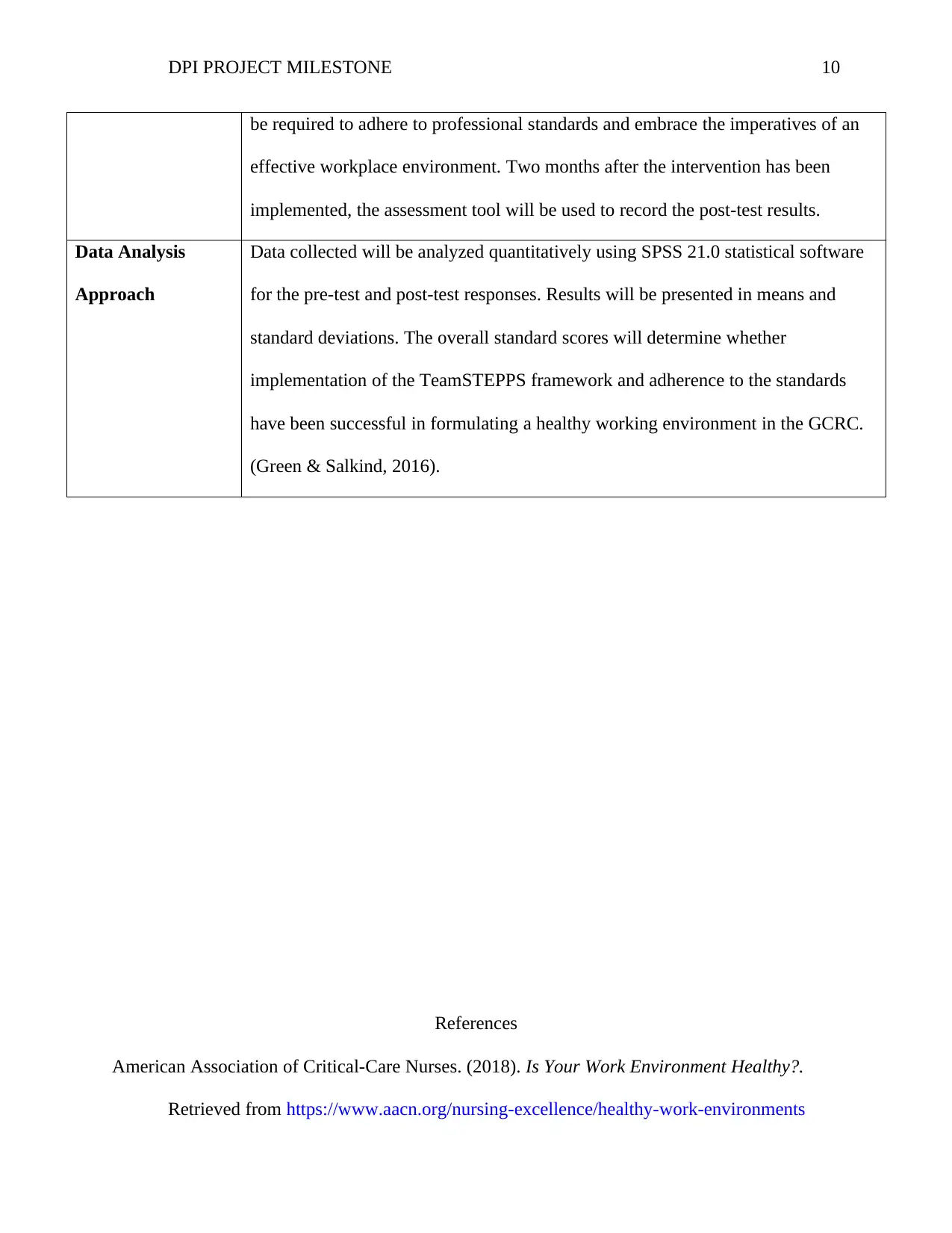
DPI PROJECT MILESTONE 10
be required to adhere to professional standards and embrace the imperatives of an
effective workplace environment. Two months after the intervention has been
implemented, the assessment tool will be used to record the post-test results.
Data Analysis
Approach
Data collected will be analyzed quantitatively using SPSS 21.0 statistical software
for the pre-test and post-test responses. Results will be presented in means and
standard deviations. The overall standard scores will determine whether
implementation of the TeamSTEPPS framework and adherence to the standards
have been successful in formulating a healthy working environment in the GCRC.
(Green & Salkind, 2016).
References
American Association of Critical-Care Nurses. (2018). Is Your Work Environment Healthy?.
Retrieved from https://www.aacn.org/nursing-excellence/healthy-work-environments
be required to adhere to professional standards and embrace the imperatives of an
effective workplace environment. Two months after the intervention has been
implemented, the assessment tool will be used to record the post-test results.
Data Analysis
Approach
Data collected will be analyzed quantitatively using SPSS 21.0 statistical software
for the pre-test and post-test responses. Results will be presented in means and
standard deviations. The overall standard scores will determine whether
implementation of the TeamSTEPPS framework and adherence to the standards
have been successful in formulating a healthy working environment in the GCRC.
(Green & Salkind, 2016).
References
American Association of Critical-Care Nurses. (2018). Is Your Work Environment Healthy?.
Retrieved from https://www.aacn.org/nursing-excellence/healthy-work-environments
Paraphrase This Document
Need a fresh take? Get an instant paraphrase of this document with our AI Paraphraser
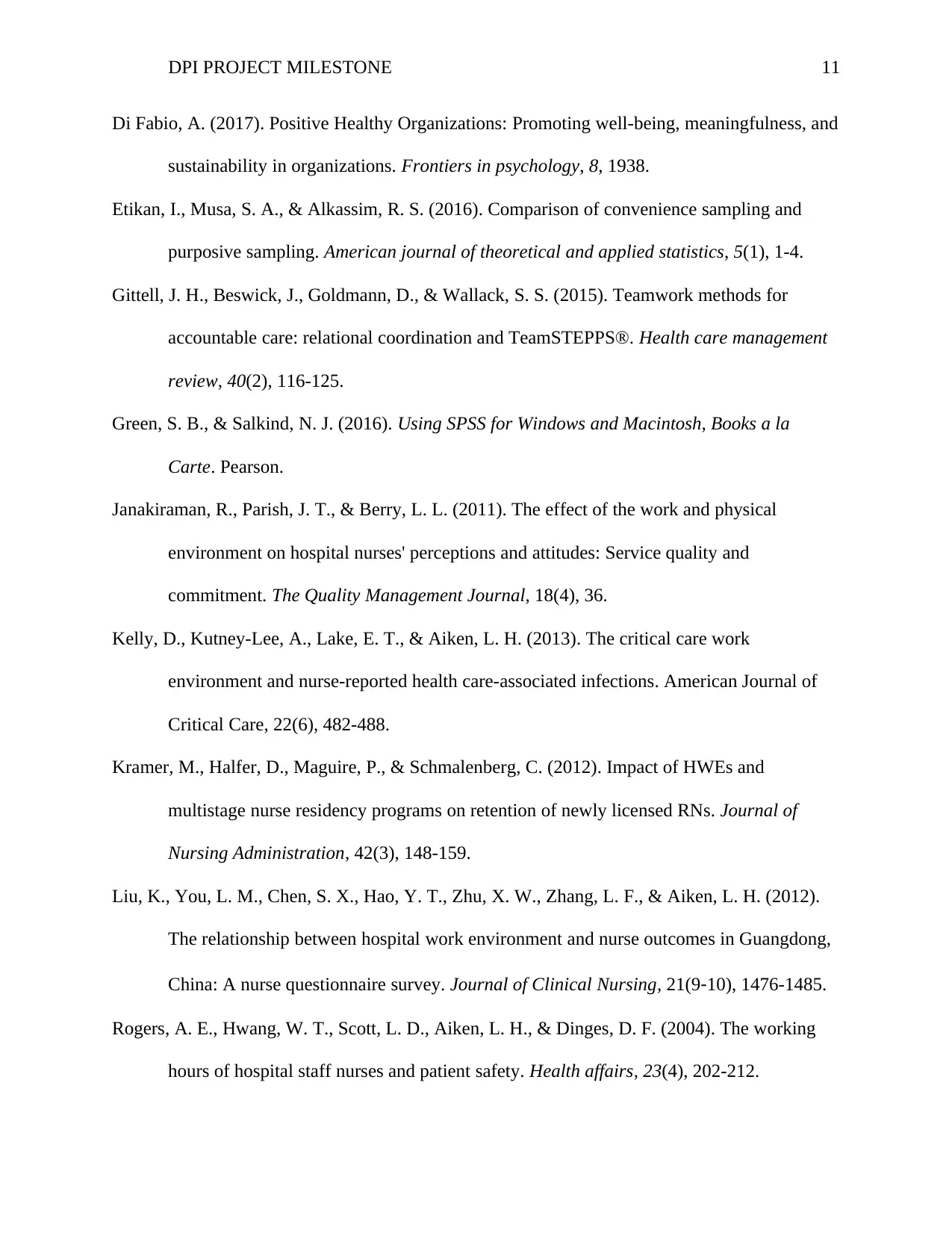
DPI PROJECT MILESTONE 11
Di Fabio, A. (2017). Positive Healthy Organizations: Promoting well-being, meaningfulness, and
sustainability in organizations. Frontiers in psychology, 8, 1938.
Etikan, I., Musa, S. A., & Alkassim, R. S. (2016). Comparison of convenience sampling and
purposive sampling. American journal of theoretical and applied statistics, 5(1), 1-4.
Gittell, J. H., Beswick, J., Goldmann, D., & Wallack, S. S. (2015). Teamwork methods for
accountable care: relational coordination and TeamSTEPPS®. Health care management
review, 40(2), 116-125.
Green, S. B., & Salkind, N. J. (2016). Using SPSS for Windows and Macintosh, Books a la
Carte. Pearson.
Janakiraman, R., Parish, J. T., & Berry, L. L. (2011). The effect of the work and physical
environment on hospital nurses' perceptions and attitudes: Service quality and
commitment. The Quality Management Journal, 18(4), 36.
Kelly, D., Kutney-Lee, A., Lake, E. T., & Aiken, L. H. (2013). The critical care work
environment and nurse-reported health care-associated infections. American Journal of
Critical Care, 22(6), 482-488.
Kramer, M., Halfer, D., Maguire, P., & Schmalenberg, C. (2012). Impact of HWEs and
multistage nurse residency programs on retention of newly licensed RNs. Journal of
Nursing Administration, 42(3), 148-159.
Liu, K., You, L. M., Chen, S. X., Hao, Y. T., Zhu, X. W., Zhang, L. F., & Aiken, L. H. (2012).
The relationship between hospital work environment and nurse outcomes in Guangdong,
China: A nurse questionnaire survey. Journal of Clinical Nursing, 21(9‐10), 1476-1485.
Rogers, A. E., Hwang, W. T., Scott, L. D., Aiken, L. H., & Dinges, D. F. (2004). The working
hours of hospital staff nurses and patient safety. Health affairs, 23(4), 202-212.
Di Fabio, A. (2017). Positive Healthy Organizations: Promoting well-being, meaningfulness, and
sustainability in organizations. Frontiers in psychology, 8, 1938.
Etikan, I., Musa, S. A., & Alkassim, R. S. (2016). Comparison of convenience sampling and
purposive sampling. American journal of theoretical and applied statistics, 5(1), 1-4.
Gittell, J. H., Beswick, J., Goldmann, D., & Wallack, S. S. (2015). Teamwork methods for
accountable care: relational coordination and TeamSTEPPS®. Health care management
review, 40(2), 116-125.
Green, S. B., & Salkind, N. J. (2016). Using SPSS for Windows and Macintosh, Books a la
Carte. Pearson.
Janakiraman, R., Parish, J. T., & Berry, L. L. (2011). The effect of the work and physical
environment on hospital nurses' perceptions and attitudes: Service quality and
commitment. The Quality Management Journal, 18(4), 36.
Kelly, D., Kutney-Lee, A., Lake, E. T., & Aiken, L. H. (2013). The critical care work
environment and nurse-reported health care-associated infections. American Journal of
Critical Care, 22(6), 482-488.
Kramer, M., Halfer, D., Maguire, P., & Schmalenberg, C. (2012). Impact of HWEs and
multistage nurse residency programs on retention of newly licensed RNs. Journal of
Nursing Administration, 42(3), 148-159.
Liu, K., You, L. M., Chen, S. X., Hao, Y. T., Zhu, X. W., Zhang, L. F., & Aiken, L. H. (2012).
The relationship between hospital work environment and nurse outcomes in Guangdong,
China: A nurse questionnaire survey. Journal of Clinical Nursing, 21(9‐10), 1476-1485.
Rogers, A. E., Hwang, W. T., Scott, L. D., Aiken, L. H., & Dinges, D. F. (2004). The working
hours of hospital staff nurses and patient safety. Health affairs, 23(4), 202-212.
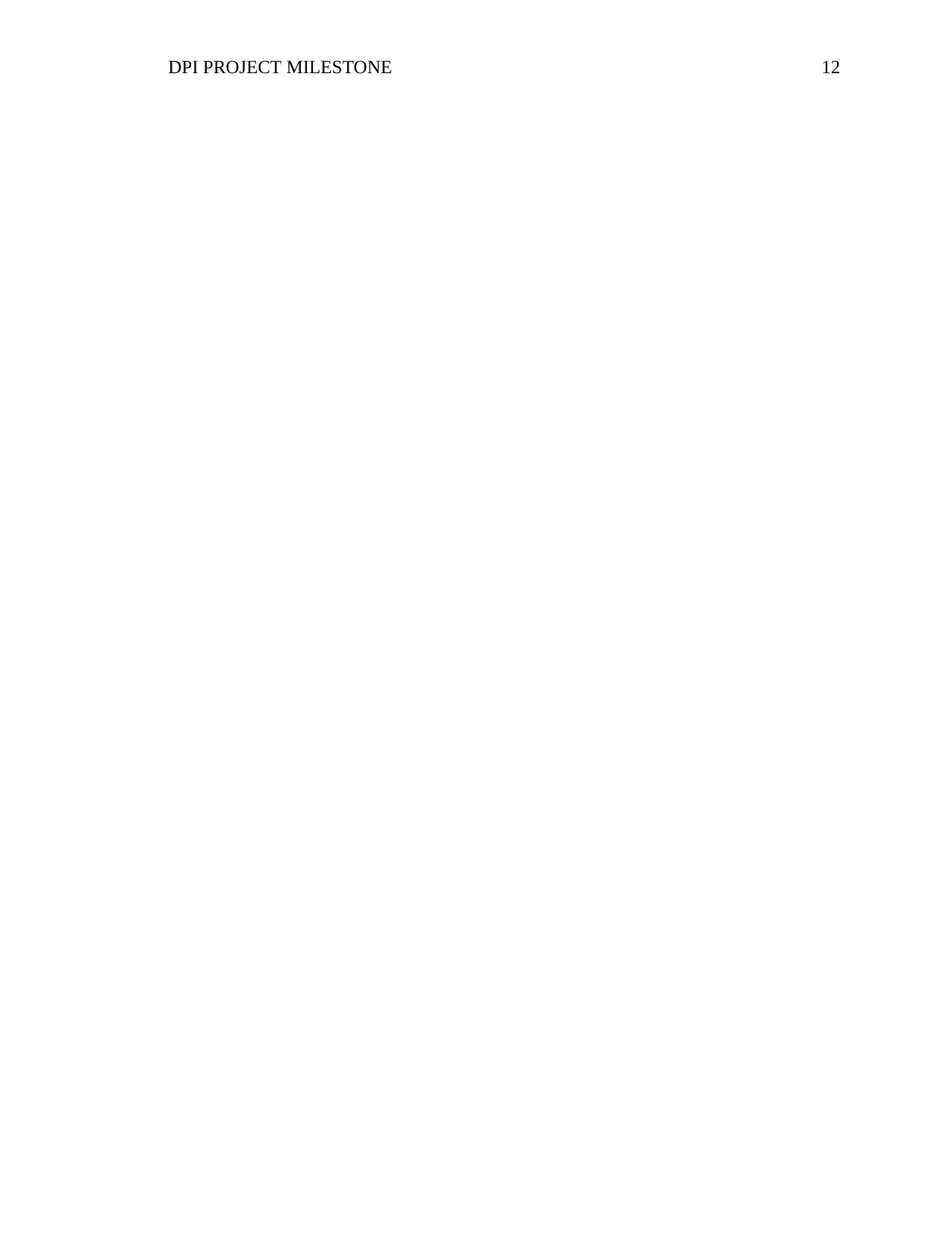
DPI PROJECT MILESTONE 12
⊘ This is a preview!⊘
Do you want full access?
Subscribe today to unlock all pages.

Trusted by 1+ million students worldwide
1 out of 12
Related Documents
Your All-in-One AI-Powered Toolkit for Academic Success.
+13062052269
info@desklib.com
Available 24*7 on WhatsApp / Email
![[object Object]](/_next/static/media/star-bottom.7253800d.svg)
Unlock your academic potential
Copyright © 2020–2025 A2Z Services. All Rights Reserved. Developed and managed by ZUCOL.





